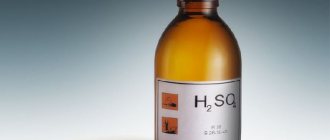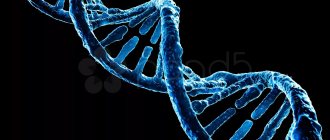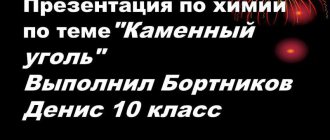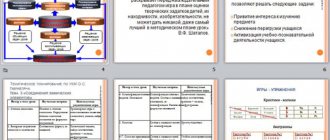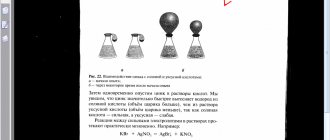so UNT / Tests / Tests in Chemistry
Chemistry 8th grade. Thematic and final tests.
03.11.2014 48474 0
Test No. 1.
Initial Chemical Concepts
Option #1
Task No. 1
Determine how many atoms the molecules consist of, how many molecules of substances, the formulas of which are given below:
5O3, N2, 2H2O, Al, P2O5, 3H2SO4.
Task No. 2
Using the following diagrams, arrange the coefficients and determine the type of each chemical reaction.
A) P + O2 = P2O5
B) WO3 + H2 = W + H2O
B) Cu(OH)2 = CuO + H2O
D) AlCl3 + KOH = Al(OH)3 + KCl
Task No. 3
Calculate the mass fractions of oxygen in these oxides. Which one is richer in oxygen?
Mn2O3, Mn2O7, MnO.
Task No. 4
Write down what mass of iron is included in the composition of iron (III) oxide weighing 60 grams.
Option No. 2
Task No. 1
Determine how many atoms the molecules consist of, how many molecules of substances, the formulas of which are given below:
SiO2, 3H3PO4, Mg, H2, 4SO3, 2Br2
Task No. 2
Using the following diagrams, arrange the coefficients and determine the type of each chemical reaction.
A) CH4 = C + H2
B) Al + Cl2 = AlCl3
B) Na + H2SO4 = Na2SO4 + H2
D) Fe2O3 + H2SO4 = Fe2(SO4)3 + H2O
Task No. 3
Calculate the mass fractions of oxygen in these oxides. Which one is richer in oxygen?
SO, SO2, SO3.
Task No. 4
What mass of aluminum oxide Al2O3 contains 27 kg. aluminum
Option #3
Task No. 1
Determine how many atoms the molecules consist of, how many molecules of substances, the formulas of which are given below:
2Al2O3, Cu, 2H2CO3, Cl2, CH3COOH, 5NaCl.
Task No. 2
Using the following diagrams, arrange the coefficients and determine the type of each chemical reaction.
A) Fe + CuSO4 = FeSO4 + Cu
B) CaCO3 = CaO + CO2
B) Na2SO4 + BaCl2 = NaCl + BaSO4
D) Li + O2 = Li2O
Task No. 3
Calculate the mass fractions of oxygen in these oxides. Which one is richer in oxygen?
Fe2O3, FeO, Fe3O4.
Task No. 4
How many grams of sodium are in 400g of pure table salt?
Option No. 4
Task No. 1
From the formulas of substances given below, separate simple and complex substances.
Ozone – O3, water – H2O, hydrogen sulfide – H2S, nitrogen – N2, diamond – C, methane – CH4, copper sulfate – CuSO4, sulfur – S8, ethyl alcohol – C2H5OH, carbon dioxide – CO2, copper – Cu, ammonia – NH3 .
Task No. 2
Using the following diagrams, arrange the coefficients and determine the type of each chemical reaction.
A) Al + O2 = Al2O3
B) Fe(OH)3 = Fe2O3 + H2O
B) CuO + H2 = Cu + H2O
D) CuCl2 + NaOH = Cu(OH)2 + NaCl
Task No. 3
Calculate the mass fractions of oxygen in these oxides. Which one is richer in oxygen?
CrO3, Cr2O3, CrO.
Task No. 4
Calculate the mass of carbon contained in 176g. carbon dioxide (CO2)
Option #5
Task No. 1
Table salt - NaCl, oxygen - O2, iron - Fe, acetic acid - CH3COOH, graphite - C, gold - Au, potassium permanganate - KMnO4, silica - SiO2, pyrite - FeS, water - H2O, phosphorus - P, carbon monoxide - CO .
Task No. 2
Using the following diagrams, arrange the coefficients and determine the type of each chemical reaction.
A)KClO3 = KCl + O2
B) Na + O2 = Na2O
B) Al2O3 + H2SO4 = Al2(SO4)3 + H2O
D) Fe + HCl = FeCl3 + H2
Task No. 3
Calculate the mass fractions of oxygen in these oxides. Which one is richer in oxygen?
N2O, NO, N2O3.
Task No. 4
Write down the mass of iron in 66g. iron (II) sulfate FeS.
Option #6
Task No. 1
Give three examples of simple substances whose molecules consist of two atoms and two examples of complex substances whose molecules consist of two atoms.
Task No. 2
Using the following diagrams, arrange the coefficients and determine the type of each chemical reaction.
A) (CuOH)2CO3 = CuO + CO2 + H2O
B) Ca + H3PO4 = Ca3(PO4)2 + H2
B) K2O + P2O5 = K3 PO4
D) CaCO3 + Na3PO4 = Na2CO3 + Ca3(PO4)2
Task No. 3
Determine the mass fraction of potassium chloride in sylvinite (KCl * NaCl) if it contains 10% impurities.
Task No. 4
What mass of copper sulfate CuSO4 * 5H2O contains 90 g. water?
Test No. 2
"Oxygen. Oxides. Combustion"
Option #1
Task No. 1
Write down equations for the following chemical reactions. Name the production of oxides.
A) Al + …= Al2O3
B) Ca + O2 = ...
Task No. 2
Complete the combustion reaction of a complex substance, arrange the coefficients
CH4 + O2 =
Task No. 3
Given the following substances: H2O and H2O2, calculate in which case, during the decomposition of equal moles of the starting substances, more oxygen will be released.
Task No. 4
From the proposed substances, write down the formulas of the oxides, name the written oxides: H2O, MgCl2, H2SO4, SO3, H2S, P2O5, Na2SiO3, Al2O3, KOH, Mn2O7.
Option No. 2
Task No. 1
Write down equations for the following chemical reactions. Name the production of oxides.
A) C + … = CO2
B) K + O2 = ...
Task No. 2
Complete the combustion reaction of a complex substance, arrange the coefficients
C2H6 + O2 =
Task No. 3
Given the following substances: H2O and KMnO4, calculate in which case, during the decomposition of equal moles of the starting substances, more oxygen will be released.
Task No. 4
From the proposed substances, write down the formulas of the oxides, name the written oxides: H2CO3, SO2, Al(OH)3, Cr2O7, H3PO4, Mn2O3, BaO, NaNO3, CuO.
Option #3
Task No. 1
Write down equations for the following chemical reactions. Name the production of oxides.
A) Fe + … = Fe2O3
B) ... + O2 = MgO
Task No. 2
Complete the combustion reaction of a complex substance, arrange the coefficients
C3H8 + O2 =
Task No. 3
Given the following substances: KClO3 and H2O, calculate in which case, during the decomposition of equal moles of the starting substances, more oxygen will be released.
Task No. 4
From the proposed substances, write down the formulas of the oxides, name the written oxides
Cu2O, K2SO4, WO3, HCl, H2O2, HNO3, N2O5, BaCl2, FeO, Zn(OH)2.
Option No. 4
Task No. 1
Write down equations for the following chemical reactions. Name the production of oxides.
A) Cu +… = CuO
B) N2…+ O2=
Task No. 2
Complete the combustion reaction of a complex substance, arrange the coefficients
C2H4 + O2 =
Task No. 3
Given the following substances: KClO3 and H2O2, calculate in which case, during the decomposition of equal moles of the starting substances, more oxygen will be released.
Task No. 4
From the proposed substances, write down the formulas of the oxides, name the written oxides
MgO, CaCO3, Fe3O4, CuCl2, SO2, NH3, N2O5, H2SO3, NaOH, K2O.
Option #5
Task No. 1
Write down equations for the following chemical reactions. Name the production of oxides.
A) Hg + … =HgO
B) ... + O2 = SO3
Task No. 2
Complete the combustion reaction of a complex substance, arrange the coefficients
C2H2 + O2 =
Task No. 3
Given the following substances: KClO3 and KMnO4, calculate in which case, during the decomposition of equal moles of the starting substances, more oxygen will be released.
Task No. 4
From the proposed substances, write down the formulas of the oxides, name the written oxides: Ag2O, Ca(OH)2, BaO, H2SO4, N2O3, CuCl2, H2O, Al2(SO4)3, CO2.
Option #6
Task No. 1
Write down equations for the following chemical reactions. Name the production of oxides.
A) SO2 + … = SO3
B) H2S + …= H2O + SO2
Task No. 2
Complete the combustion reaction of a complex substance, arrange the coefficients
C4H10 + O2 =
Task No. 3
It is known that the majority of the human body is oxygen (the mass fraction of oxygen is approximately 65%). Calculate the mass of oxygen in the body of a person weighing 50 kg. Find the mass of oxygen in your body.
Task No. 4
Write out the formulas from the formulas below:
a) metal oxides, b) non-metal oxides, give names:
SiO2, NH3, H2CO3, CaO, KOH, CH4, Cr2O3, BaS, PbO2, HClO3, HF, V2O5, NO.
Test No. 3
Hydrogen. Acids. Salt.
Option #1
Task No. 1
Write down the reaction equations for the interaction of hydrogen with a) oxygen, b) mercury (II) oxide, c) sodium.
Task No. 2
Which of these substances does sulfuric acid Ca, O2, CuO, CO2, K2O react with? Write the reaction equation, arrange the coefficients, name the production of salt.
Task No. 3
From this list of substances, write down the formulas of acids and salts, give them names, underline the acidic residue and determine its valency. H2O, Mg(NO3)2, HCl, SO3, CaCO3, H3PO4, NaOH, BaSO4, HNO3, Cl2.
Task No. 4
Calculate the amount of substance and mass of zinc that can completely react with 980 grams of sulfuric acid.
Option No. 2
Task No. 1
Write down the reaction equations for the interaction of hydrogen with a) bromine, b) lead oxide, c) magnesium.
Task No. 2
Which of these substances does phosphoric acid Na, O2, MgO, CO2, ZnO react with? Write the reaction equation, arrange the coefficients, name the production of salt.
Task No. 3
From this list of substances, write down the formulas of acids and salts, give them names, underline the acidic residue and determine its valency.
BaCl2, Al(OH)3, HNO3, NH3, CuSO4, H2SiO3, Br2, Na2S, HCl.
Task No. 4
Calculate the amount of substance and the mass of copper (II) oxide that reacted with hydrogen if the result was 192 grams of copper.
Option #3
Task No. 1
Write down equations for the reaction of hydrogen with a) chlorine, b) tungsten oxide, c) potassium.
Task No. 2
With which of these substances does hydrochloric acid Mg, Cu, P2O5, Al2O3, CaO react? Write the reaction equation, arrange the coefficients, name the production of salt.
Task No. 3
From this list of substances, write down the formulas of acids and salts, give them names, underline the acidic residue and determine its valency.
CO2, MgCl2, H2CO3, KOH, H2S, H2O2, Na2, SO3, P, Ca3(PO4)2, H2SO4.
Task No. 4
Calculate the amount of substance and mass of copper (II) oxide that completely reacted with sulfuric acid, if it is known that 48 grams of copper sulfates were obtained in this reaction.
Option No. 4
Task No. 1
Write down the reaction equations for the interaction of hydrogen with
a) iron (III) oxide, b) sulfur, c) nitrogen.
Task No. 2
With which of these substances does nitric acid react? Ba, Ag, SO2, K2O, Al2O3. write the reaction equation, arrange the coefficients, name the production of salt.
Task No. 3
From this list of substances, write down the formulas of acids and salts, give them names, underline the acidic residue and determine its valency. NaNO3, P2O5, H2SO4, S, HBr, K2SiO3, FeCl3, H3PO4.
Task No. 4
Calculate the amount of substance and the mass of hydrogen that is formed when 8 mol of Al reacts with hydrochloric acid.
Option #5
Task No. 1
Write down the reactions for the production of hydrogen as a result of the interaction of zinc with acids: a) hydrochloric; b) sulfur; c) phosphorus.
Task No. 2
In the given diagrams, insert the formulas of unknown substances, write the reaction equations, give the names of the reacting substances and reaction products:
a) X+H2SO4 →ZnSO4+Y
b) MgO+X→Y+H2O
c) X+Y→Ca3(PO4)2+H2O
Task No. 3
Which oxides correspond to the following acids, write down their formulas: H2SO4, H3PO4, H3PO3, H3BO3, H2SiO3.
Task No. 4
Calculate in which of the following cases more hydrogen is formed in the reactions of hydrochloric acid HCl with:
a) 3.2 g aluminum
b) 3.2 g zinc
Option #6
Task No. 1
Give examples of reactions: a) decomposition; b) substitutions in which hydrogen is released as a reaction product.
Task No. 2
Write the reaction equations that can be used to carry out transformations:
Al2O3→Al→ Al2O3→ Al2(SO4)3
Task No. 3
In the given formulas of the salts Na2S, Na3PO4, AlCl3, Fe2(SO4)3, Na2CrO4, CaI2, highlight the acidic residues, determine their valence, and give the formulas of the corresponding acids.
Task No. 4
6 moles of phosphorus were burned. The resulting oxide was dissolved in water. Determine the mass of phosphorus oxide formed during combustion.
O – cross-section of knowledge in chemistry, grade 9
Task No. 1
Write down the reactions for the production of hydrogen as a result of the interaction of zinc with acids: a) hydrochloric; b) sulfur; c) phosphorus.
Task No. 2
In the given diagrams, insert the formulas of unknown substances, write the reaction equations, give the names of the reacting substances and reaction products:
a) X+H2SO4 →ZnSO4+Y
b) MgO+X→Y+H2O
c) X+Y→Ca3(PO4)2+H2O
Task No. 3
Which oxides correspond to the following acids, write down their formulas: H2SO4, H3PO4, H3PO3, H3BO3, H2SiO3.
Task No. 4
Calculate in which of the following cases more hydrogen is formed in the reactions of hydrochloric acid HCl with:
a) 3.2 g aluminum
b) 3.2 g zinc
Task No. 5
Give examples of reactions: a) decomposition; b) substitutions in which hydrogen is released as a reaction product.
Task No. 6
Write the reaction equations that can be used to carry out transformations:
Al2O3→Al→ Al2O3→ Al2(SO4)3
Task No. 7
In the given formulas of the salts Na2S, Na3PO4, AlCl3, Fe2(SO4)3, Na2CrO4, CaI2, highlight the acidic residues, determine their valence, and give the formulas of the corresponding acids.
Task No. 8
6 moles of phosphorus were burned. The resulting oxide was dissolved in water. Determine the mass of phosphorus oxide formed during combustion.
